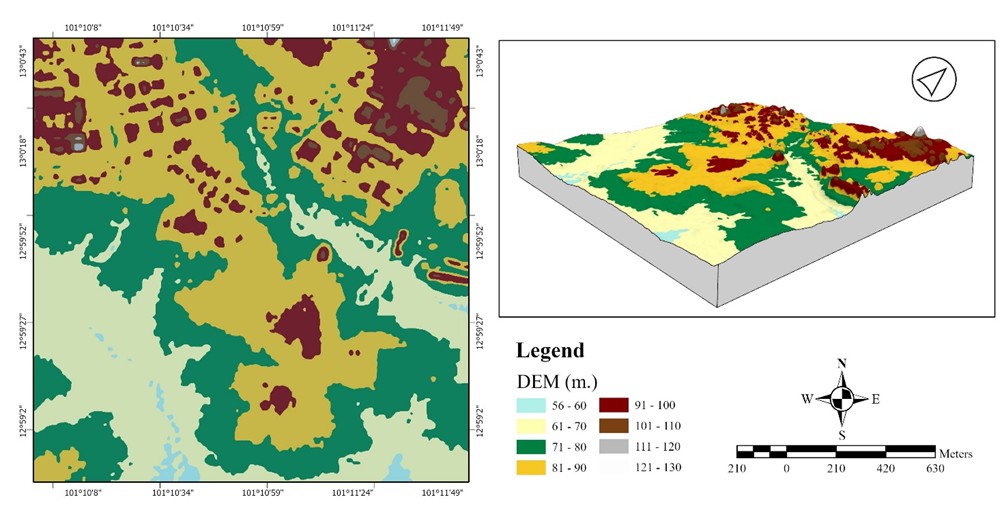Techno-Economic Assessment of Utility-Scale Dual-Rotor Wind Power Generation: A Case Study of Siam Eastern Industrial Park, Rayong Province, Thailand -
Main Article Content
Abstract
The energy transition to renewables is considered one of the primary ways to limit the emissions of greenhouse gases (GHG), as the electricity sector is among the major users of fossil fuels. Solar and wind power are leading the way and becoming more cost-effective than coal and other fossil fuels. As renewable energy is becoming more economical, industries worldwide are adopting it to reduce their carbon footprints. This study is aimed at the techno-economic assessment of a 20 MW utility-scale dual-rotor wind power plant installed at Siam Eastern Industrial Park in the Rayong province of Thailand. Using the MERRA-2 wind database, Digital Elevation Model (DEM), and the rough digital data of the study area, computational fluid dynamics (CFD) wind flow modeling was used to create a microscale wind resource map of the study area. The modeling yielded an average windspeed of 5.4 m/s at the hub height of 90 m above ground level (agl). Using four 5 MW dual-rotor wind turbine generators, the wind power plant would have an annual energy production (AEP) of 75.7 GWh/yr with a capacity factor (CF) of 43%. The economic assessment of the power plant was performed using various economic indicators, notably the benefit-cost ratio (BCR), the net present value (NPV), the internal rate of return (IRR), and the payback period (PBP) at different benefit scenarios defined by the Provincial Electricity Authority of Thailand (PEA) and private power purchase agreements. The financial parameters were all positive for each of the PEA’s benefits scenarios, even without the carbon trading benefits, thus making this wind power plant economically viable. Studies like these are essential to build the confidence of investors and developers by providing them with well-informed information on the feasibility of wind power plant projects and their benefits, thus contributing to the development of wind energy in various jurisdictions.
Article Details

This work is licensed under a Creative Commons Attribution-NonCommercial-NoDerivatives 4.0 International License.
References
Statista. World Electricity Generation Shares by Source 2022, 2022. https://www.statista.com/statistics/269811/world-electricity-production-by-energy-source/. (accessed July 15, 2023).
UNFCCC. Adoption of the Paris Agreement - Paris Agreement text English, 2015. https://unfccc.int/sites/default/files/english_paris_agreement.pdf. (accessed July 10, 2023).
In International Renewable Energy Agency (IRNEA). Renewable Power Generation Costs in 2021, 2021. https://www.irena.org//media/Files/ IRENA/Agency/Publication/2018/Jan/IRENA_2017_ Power_Costs_2018.pdf. (accessed July 21, 2023).
Electricity Generating Authority of Thailand (EGAT). Annual Report 2021 Electricity Generating Authority of Thailand, 2021. https://www.egat.co.th/home/en/annual-report/. (accessed July 20, 2023).
Energy Regulatory Commission of Thailand (ERC). Annual Report 2021, 2021. https://www.erc.or.th/en/annual-report. (accessed May 26, 2023).
Ministry of Energy. Thailand Power Development Plan (2015-2036), 2016. https://www.egat.co.th/en/images/about-egat/PDP2015_Eng.pdf. (accessed June 26, 2023).
Waewsak, J.; Chancham, C.; Chiwamongkhonkarn, S.; Gagnon, Y. Wind Resource Assessment of the Southernmost Region of Thailand Using Atmospheric and Computational Fluid Dynamics Wind Flow Modeling. Energies, 2019; 12(10), pp. 1899. https://doi.org/10.3390/en12101899.
Chancham, C.; Waewsak, J.; Gagnon, Y. Offshore Wind Resource Assessment and Wind Power Plant Optimization in the Gulf of Thailand. Energy, 2017; 139, pp. 706–731. https://doi.org/10.1016/j.energy.2017.08.026.
Niyomtham, L.; Lertsathittanakorn, C.; Waewsak, J.; Gagnon, Y. Mesoscale/Microscale and CFD Modeling for Wind Resource Assessment: Application to the Andaman Coast of Southern Thailand. Energies, 2022; 15(9), pp. 3025. https://doi.org/10.3390/en15093025.
Murthy, K. S. R.; and Rahi, O. P. A Comprehensive Review of Wind Resource Assessment. Renewable and Sustainable Energy Reviews, 2017; 72, pp. 1320–1342. https://doi.org/10.1016/j.rser.2016.10.038.
Dhunny, A. Z.; Lollchund, M. R.; Rughooputh, S. D. D. V. Wind Energy Evaluation for a Highly Complex Terrain using Computational Fluid Dynamics (CFD). Renewable Energy, 2017; 101, pp. 1–9. https://doi.org/10.1016/j.renene.2016.08.032.
Gravdahl, A. R.; Vargvei, N. Meso Scale Modeling with a Reynolds Averaged Navier - Stokes Solver Assessment of wind resources along the Norwegian coast. 31st IEA Experts Meeting State of the Art on Wind Resource Estimation, B. Maribo Pedersen, Risø, Denmark, October 29-30 1998, pp. 31 – 45.
Durán, P.; Meiβner, C.; Casso, P. A New Meso-Microscale Coupled Modelling Framework for Wind Resource Assessment: A Validation Study. Renewable Energy, 2020; 160, pp. 538–554, Nov. 2020, https://doi.org/10.1016/j.renene.2020.06.074.
WindSim. WindSim 11.0, n.d. https://windsim.com/software/windsim-11-0/. (accessed July 18, 2023).
Rienecker, M. M.; Suarez, Max. J.; Gelaro, R.; Todling, R.; Bacmeister, J.; Liu, E.; Bosilovich, M. G.; Schubert, S. D.; Takacs, L.; Kim, G-K.; Bloom, S.; Chen, J.; Collins, D.; Conaty, A.; Silva, A. da.; Gu, W.; Joiner, J.; Koster, R. D.; Lucchesi, R.; Molod, A.; Owens, T.; Pawson, S.; Pegion, P.; Redder, C. R.; Reichle, R.; Robertson, F. R.; Ruddick, A. G.; Sienkiewicz, M.; Woollen, J. MERRA: NASA’s Modern-Era Retrospective Analysis for Research and Applications. Journal of Climate, 2011; 24(14), 3624-3648. https://doi.org/10.1175/JCLI-D-11-00015.1.
Jet Propulsion Laboratory. ASTER Global Digital Elevation Map, 2012. https://asterweb.jpl.nasa.gov/gdem.asp. (accessed May 23, 2023).
Land Development Department. Land Use, 2013. http://www1.ldd.go.th/ldd/. (accessed July 21, 2023).
Rosenberg, A.; Selvaraj, S.; Sharma. A. A Novel Dual-Rotor Turbine for Increased Wind Energy Capture, The Science of Making Torque from Wind 2014 (TORQUE 2014). IOP Publishing Ltd., Copenhagen, Denmark June 18 - 20 2014, pp. 012078.
Wang, Y.; Sun, T. Life Cycle Assessment of CO2, Emissions from Wind Power Plants: Methodology and Case Studies. Renewable Energy, 2012; 43, pp. 30–36. https://doi.org/10.1016/j.renene.2011.12.017.
Office of Analysis and Evaluation. Thailand Grid Emission Factor for GHG Reduction Project/Activity, 2017. http://ghgreduction.tgo.or.th/images/Grid_Emission_Factor_2559_-_Finalised.pdf. (accessed July 21, 2023).


